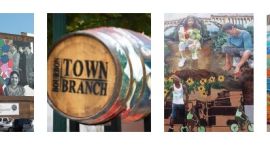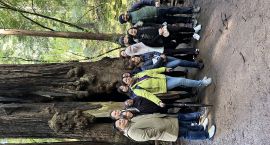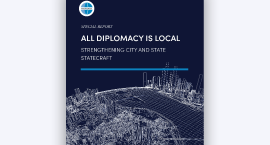When taco trucks first arrived in the United States in the 1970s as workers from Mexico migrated to California, the menus combined Mexican food with American tastes. Now, food trucks are used for almost any cuisine imaginable and have revolutionized the way food is sold throughout the United States; however, Mexican food trucks have not always been welcomed by local governments, the public, and the culinary world. Today on cultureXchanges, we are having an engaging conversation with scholar and filmmaker Dr. Robert D. Lemon on the contribution of Mexican food trucks to urban space, public policy, and American cuisine.
Episode Transcript
TK Harvey – Hello and welcome to cultureXchanges, a podcast at the intersection of the humanities and cultural diplomacy. I’m your host, Terry Harvey, Vice President of the Meridian Center for Cultural Diplomacy. This podcast series explores the impact of the arts and culture on diplomatic relations across the world through discussions with cultural diplomacy experts.
Today on cultureXchanges, we are having an engaging conversation with scholar and filmmaker, Dr. Robert D Lemon on the contribution of Mexican food trucks to urban space, public policy, and American cuisine. When taco trucks first arrived in the United States in the 1970s, and as workers from Mexico migrated to California, the menus combined Mexican food with American taste. Now food trucks are used for almost any cuisine imaginable, and they have revolutionized the way food is sold throughout the United States. However, Mexican food trucks have not always been welcomed by local governments, the public, and the culinary world. Dr. Lemon is a contemporary cultural and urban geographer grounded in the fundamentals of urban and environmental design. His work cuts across foodways, Latin American migration, communication, geography, neoliberalism, and the rights of the city. Dr. Lemon is currently a research fellow in the Department of Geography and the Environment at the University of Texas in Austin and a member of the editorial board for Taste of the City Journal.
________________________________________________________________________________________________
TK Harvey – Thank you so much, Dr. Lemon, for joining us. I really look forward to diving into your expertise around the subject. I thought we might give our audience just a brief history first of Mexican food trucks in the United States.
Dr. Lemon – Well, if we go with food trucks, you know, the food that’s been street food … Mexican street food has been in LA, Chicago, and San Antonio since the early 1900s, even the late 1800s. But the trucks themselves, you can probably trace them back to the early 1970s. And that came about for a variety of reasons. One is the number of Mexican immigrants coming into California in the 1970s to work in the fields, the agricultural industry. They would rotate through, and at that period of time, they weren’t really trying to settle here and get US citizenship. They would migrate in pretty freely, work the fields, and then they’d go back to the Mexico until it was time to harvest something again, and they would kind of rotate with the crops that were popping up. Some innovative Mexicans realized, “Hey, there’s these sandwich trucks that go around to the industrial parks and take food to the workers who work at Boeing or whatnot in California and LA.” They thought “Well, let’s do the same, but we’ll take our tacos and we’ll go out to where the Mexicans are.” And the Mexicans aren’t doing skilled labor in the factories. They’re out picking fruit in the fields of California, so their routes are a little different. They’re having to drive further and they’re having to migrate with the workers to bring the food out..
Around 1974, I would say 75’, a couple of these trucks were just like “I’m done driving around. It costs too much in gas, and I have to fix the truck. Often the people I’m feeding never pay me. They run up a tab and never pay us. This is costly.” It was a bad business model, essentially. So, they started parking in Latino neighborhoods. Those were the first two that I could find. There were probably other ones, but you know, no one’s going around California in the 1970s and saying “This is the first taco truck in the state or on the street.” That kind of evidence doesn’t exist, but what you can find and trace back is that there was a truck in LA called “King Taco,” which essentially is still there and still the longest-operating taco truck. There’s a restaurant behind it now in East LA. And there was another truck. I feel confident enough in saying based on my interviews in Sacramento. That there’s been a truck parked in that neighborhood since 1974 as well. And there may have been trucks prior to those that we don’t know about, but at least we can trace the history of two trucks.
TK Harvey – Yeah, the evolution of this history is a moving target. I’m sure it’s really hard to nail down from an academic point of view. But I think it’s clear that the public debate around taco trucks has been framed in a variety of ways: an issue of racism, discrimination issues related to public safety and health, the question of immigration rights. How have different communities, governments, and public policies responded to food trucks within urban areas?
Dr. Lemon – It often depends on the neighborhoods they move into and who they’re trying to sell to. And what those neighborhoods have going on, what their demographics are like, what their education levels are like. Then you toss a taco truck into that mix, and then you often get some sort of conflict. Not always, but sometimes you’re well-accepted and sometimes it just takes time for people to change their mind about it. And I’d just like to point out that I’m not a proponent or advocate of like having taco trucks everywhere. They’re great things. And I come from the perspective of a human geographer. I want to know what’s going on around these trucks. And then there are real issues that can’t just be dismissed. For example, it’s interesting to note that when I was researching in Columbus, Ohio, many of the trucks were moving into poor, white neighborhoods that tended to be poorly educated and fairly racist. And they would shoot BBs at the trucks and say “They aren’t supposed to be here. They’re not here legally. They’re trashy. There’s trash everywhere. They’re stealing electricity. They’re not paying to be on the lot.” And then if you go through all these things, you find out that they are paying to be on the lot. They do have a permit for electricity. They’re paying the meter for a hook up there. They’ve gone through city regulations to have their food truck there, and they have a health permit. Everything’s on the up and up. And then the argument just comes down to “Well, they’re not legal.” The residents say “That’s not — they’re here illegally” or, in their terms, “they’re illegal.” Right? Not my words. “Undocumented” would be the correct term, I guess. So, in that stage, they lose their argument. The trucks get to stay, you know, for various reasons and maybe go to Sacramento, CA or actually Oakland, as I’ve discovered.
In Oakland, the trucks are everywhere and the city sort of turns a blind eye to it. And if you do go to the trucks, most of the guys working the trucks — many of them who own the trucks now migrated in the 1970s and 80s and have amnesty. So they’re here 100% legally. They have papers to document it. And often if you’re in East Oakland, they let a lot of things slide. But what I found going to many of the trucks is that there are no health permits, and they are trashy, and there are roaches running around. There are these problems here, but the city’s got so much going on that the truck can just be there. And they’re in Latino neighborhoods so no one’s really complaining. The only people who sort of complain about the trucks are maybe other Mexican establishments who have a brick and mortar, but that’s sort of minimal. In LA, that was prevailing. You’d have many Mexican restaurants with brick and mortars, and they didn’t like the trucks just pulling up right in front of their business and selling. And then the argument there was, you know, “I’m paying property taxes, I’ve got overhead, I have rent and my margin, I have to charge more for my tacos so I can make ends meet. And it’s not fair for a truck just to pull up in front of my restaurant and sell tacos at the lower price.” So that’s how the variety of issues can go.
TK Harvey – Yeah, a variety of challenges, right. Certainly some of those pioneering food truck owners really do depend on so many variables in terms of location, which city, which neighborhood, which demographic. It’s really fascinating. I thought we could dive a little into the cultural aspect of food trucks. And really how have Mexican food trucks and street food impacted the American culinary landscape? Perhaps more specifically, how can this exchange be viewed in the context of cultural diplomacy?
Dr. Lemon – Well, I’ll give you a good example that I heard from many neighbors in Columbus, OH. When the trucks are first moving in, they’re like “These are eyesores. They’re not paying.” You know, all the businesses are mad because they’re paying Better Business Bureau overhead. And these trucks are there and they look ugly and distract people. “No one wants to come into the neighborhood and go to my business. There’s this ugly truck there. This is an eyesore and it degrades the neighborhood.” So, there are those sorts of arguments about the trucks. And that was, I would say, around 2004, 2005. And then around 2012, everyone’s like, “Yeah, we love the trucks.” Everyone goes to them — all different people, not just the Latinos, but now you’ve got blacks, whites, you name it. They’re all going to the trucks to eat. And you have people coming across the city to venture there and go to the trucks to eat. A few of the residents told me “Well, we had a freeze one year. We lost power, and the only things open were these taco trucks because they all had backup generators and thought ahead. So, we’re hungry and it’s like, well, I guess we either go hungry or we go eat at one of these trucks.” And then they went and ate at the trucks. And said “I got there and the whole neighborhood was lined up at these trucks. It’s the only place to get anything to eat at all. And then we found out and we’re like, wow, this is delicious and it’s cheap.” And they said, “The next thing you know, the whole neighborhood is going to the trucks.” The neighborhood came to embrace the trucks because, as they said, it was good food and they liked the value.
But the sort of diplomacy aspect of it is that they got to meet someone they probably wouldn’t have engaged with before and realized that these taco truck owners, you know, they’re humans too. They’re out here trying to make a living. They’re new in this country. They’ve only been here a month or two, many of them, and they already have a business. They set up shop. They’re entrepreneurs. They’re hard workers. They have a family, their kids are at school, they’re playing soccer. And around the food, you have diverse communities coming together, talking, exchanging life circumstances, and realizing … You know, it’s kind of like “green pants with nobody inside them,” that line by Dr. Seuss. Like they’re not so scary after all. Right?
TK Harvey – That’s right, I mean I —
Dr. Lemon – They become good pals and then they, you know —
TK Harvey – Right.
Dr. Lemon – Yeah, it happens because of the social glue of food, I would say. Because food allows people to come together, eat, talk and exchange. And then most people when they’re eating, they’re in a good mood because you can get a little dopamine rush and, you know, you’re feeling good again. You got your energy and you want to chat while you’re eating. And when you go around most taco trucks, Latinos like to talk to each other and hear about what’s happening in the neighborhood and the community and what’s going on back in Mexico.
TK Harvey – So yeah, do you feel like taco trucks aren’t celebrated enough? And in having that community-building sort of mechanism to it? I mean, there’s something to say about multicultural folks coming together on the street, standing next to each other, eating next to each other. There is a sense of communal power to the food truck industry, right? It’s pretty fascinating.
Dr. Lemon – Yeah, most definitely.
TK Harvey – So in your book, The Taco Truck: How Mexican Street Food is Transforming the American City (I would encourage everybody to pick up a copy and learn more), you state that taco trucks are more than just trendy spots for Mexican cuisine, but really crucial windows into society. Can you speak more about the social importance of these taco trucks?
Dr. Lemon – Well, I would say from my experience researching the trucks … Because I began working with the trucks when I was working for the city of Columbus, OH in the Planning Department. There was no Twitter at the time and no Instagram. So, no one’s tweeting food spots and no one’s taking pictures of their culinary adventures at this point. The trucks were there to serve a purpose and that was to feed communities in a very affordable way and workers mainly. And they had a direct purpose to just feed that community and the workers. There was nothing shiny or nice about it per se. Then you got the … I think it was the Kogi Korean Taco Truck in LA who started using Twitter to tweet their locations and this became really cool. The “hybridity” of finding a truck parked somewhere in a different part of the city every day. And having this new food, this novel food, which is Korean BBQ tacos. It’s hybrid and a very, you know, “LA” sort of cuisine. That became sort of the trend at the time. And if you look at who’s following the trend, well, it’s not the Mexican day laborers. They’re out working.
TK Harvey – Right.
Dr. Lemon – They need to stop at the truck on the way home because it’s convenient and cheap. They don’t have time to go out of their way and explore new neighborhoods and try a different cuisine. It’s typically middle-class Anglos for the most part. They’re getting on Twitter and doing their urban adventures. Then Instagram came along and then you can take a picture of it and geocode that with the right like: “I just had some amazing food in this neighborhood I’ve never been to and check out the scenery.” So, when I started writing about this, it was like “Oh yeah, you’re doing those cool food trucks that drive around and tweet their location.” I’m like “No, I do the taco trucks,” and they’re like “Yeah, that’s what they are.” I’m like “No, those are, well, they’re food trucks. Some of them might be serving tacos, but no, I’m looking at the Mexican taco trucks.” And they’re really complicated things because, all of a sudden, now I have to address this whole new food industry trend that I didn’t have any interest in writing about. I was trying to avoid it, but I couldn’t. I had to address it, and not only did I have to address it, but their practices are very different from the taco trucks’ practices and their purposes are very different. And you could see issues being conflated in city policy. They look at the trucks and say you can do x, y, and z. Well that’s great for these newer trucks, but it doesn’t help the taco trucks. And they were being left out of the conversation in many ways because many of the taco truck owners weren’t showing up to the city meetings which their businesses were directly affected by. And the only owners that were there representing themselves were English-speaking, white people who owned the newer trucks. And so, their representation wasn’t at the table.
So, I guess my point was that they have this sort of cultural purpose. There are people relying on those cheap eats and not only that. When you go to the truck — again, as I mentioned before — when you’re eating at the truck, there are other people around you from your demographic and maybe from your hometown. And often you would see people like, “Hey, these people are from my hometown. This food, these types of tacos are from my hometown.” They might even know each other, and if they didn’t know each other, they might have friends in common. And then they’re talking about their community back in Mexico. They’re displaced communities that are still in existence and pick a form around these trucks. That you don’t see chasing the newer trucks around. It’s based on cultural importance, and many of them are never going back to Mexico again. They’re here and sometimes they will eat the food and they’re like ”The foods, the cuisine, they remind me of home. They remind me of family and friends.” The food itself is more in the comfort food category for Mexicans because they’re eating something they know and they’re familiar with. And it reminds them of a home and a past time. Whereas if you’re going out and trying new cuisines, these are not comfort foods. These are new foods, and they serve a whole different psychological and emotional purpose.
TK Harvey – Yeah, there’s definitely a distinct difference there. I appreciate you outlining that for our audience. I wanted to get into some of your work in Columbus. In addition to your work in academia, you’re also a filmmaker. In 2014, you directed a series of vignettes entitled Transfusion on Mexican Food Trucks in the Surrounding Community in Columbus, OH. Specifically, some of the businesspeople and community members you portrayed on screen were, in fact, undocumented. Can you talk about the challenges you faced when capturing their stories? Why it is important to tell these stories of undocumented peoples within the scope of the overall American cultural exchange?
Dr. Lemon – It wasn’t too hard to capture it. Surprisingly, most of the immigrants in Columbus were not coming from the big industrial regions of Mexico like Mexico City or Guadalajara, which is typically the case of 80s and 90s migrants. The 2000 migrants were coming from more rural areas of Mexico primarily due to NAFTA policies. It affected rural communities a little bit more, especially agricultural-producing communities. So, these people are now coming in, and you find out the more rural people from Mexico are very trustworthy individuals. They’re very kind and they have very unique cuisines. They’re not just the straight up street tacos that you would find in Mexico City and Guadalajara. Not to say that there’s not a huge variety of street tacos in both of those cities. There are, but this is beyond that scope. You’re seeing them prepare enchiladas potosinas with the Oaxacan-style atole and tlayudas. And so, you have this huge variety of food now from these trucks — especially in Columbus, OH, which is amazing. It’s like, wow, you can go around Columbus, OH, and you can eat at pretty much every state of Mexico and have quite diverse cuisines. Whereas if you’re in California, it’s just the same old Guadalajara-style tacos, which is a variety of three or four of them. You know, barbacoa, carnitas, or something of that sort. And then here in Columbus, OH, you’re like “I’m getting Oaxacan food. I’m getting stuff from San Luis Potosí, and there’s Veracruz.” And it’s all absolutely delicious. You know, there’s the Mexican City variety too. So, they were just very excited. I was filming around them and they’re just very open like “Oh, come in and film. And let me tell you about the …“ They’re just super sweet, super kind. And, of course, I couldn’t reveal who or what their names are, and I didn’t do some bios. But they were very open to letting me film and research and ask questions. Now … what was the second part to that?
TK Harvey – Well, just really, I mean —
Dr. Lemon – The story behind it?
TK Harvey – Yeah, that’s right.
Dr. Lemon – All of us, unless we’re Native American, have some sort of immigrant story.
TK Harvey – That’s right, exactly.
Dr. Lemon – It’s all like lost in the past, you know? It just disappears. No one’s ever thinking that the present one day will be important to study for somebody, and so we should capture it now. While digging through documents from the past, maybe someone 20 years from now would be like, “Oh, let’s explore this.” Or even a hundred years from now. “Let’s explore this topic.” A hundred years ago, there were migrants in the city and it would be like “Oh, guess what? Someone has a study directly on this, capturing …” It would have made our lives a lot easier as historians today if someone was doing that a hundred years ago. Capturing it, right?
TK Harvey – That’s right.
Dr. Lemon – Like a camera taking a picture. So I always feel like these cuisines in this time period only exist while we’re looking at them. It will transform over time. These foods may disappear, or they might transform into a new hybrid. And the food is always evolving. These stories and the struggles of these people — what they’re doing here, why they’re here — are important to understand. There are larger political structures, global political issues taking place that drive individual behavior. You can see how it gets played out at that human level when you’re interviewing people who are a direct cause of that here in this country.
TK Harvey – Yeah, in a lot of ways, it’s important to celebrate the impact of undocumented workers on our society and on our culture. It’s really an uncelebrated phenomenon, but in the space of cultural exchange and diplomacy, they are tremendous contributors to our society and, in this case, culinary diplomacy. So, we really appreciate your work in that space. As a human geographer, I’ll leave you with this final question and this is speaking more broadly. What are your observations on how the exchange of culinary traditions can build mutual understanding amongst different communities? Quite a broad subject matter there.
Dr. Lemon – I always find it great. To kind of reiterate what I brought up earlier, which is that foods are “social glue,” and every community can bring something to the table. And I think we’re getting to a point, at least in our society, where we have a more open perspective towards food, especially in our cities now. It used to be … there used to be the foodie part of the city where you wanted to try new foods, but now it seems like you have a lot of denizens that are very informed about all sorts of cuisine and like to eat everywhere. And I wouldn’t necessarily call them “foodies.” They just enjoy food and they’re very diverse in their knowledge of food. They’ll go eat Japanese one day. And I think that’s just part of globalization and urbanization, that those foods, global foods, will just become our everyday food. So as we see that happening, I think that food itself will become a bridge between the people cooking it and the people eating it and other people who want to share and cook those foods.
TK Harvey – Yeah. I mean, culinary diplomacy is something that’s quite powerful, as you’ve well put it. You know, in a lot of ways, food trucks and even Mexican taco trucks laid the early foundation of that cultural understanding through food and community building, so it’s really a fascinating subject. I want to commend you for the great scholarship you’ve led over the years, and I really appreciate your time.
Dr. Lemon – Thank you very much, Harvey, for having me on. It was fun to revisit the topic. It’s been a while since I’ve looked at the stuff.
TK Harvey – Well, thanks a lot.
TK Harvey – Thank you for joining us today on cultureXchanges, a podcast that examines the impact of cultural diplomacy in its many forms on global relations. We’d like to thank the National Endowment for the Humanities for funding this podcast, our guest on this episode for taking the time to share their expertise, our podcast editor, Ed Bishop, and our listeners for taking the time to engage in the world of cultural diplomacy.
Any views, findings, conclusions, or recommendations expressed in this web page do not necessarily represent those of the National Endowment for the Humanities.

















